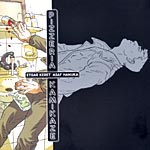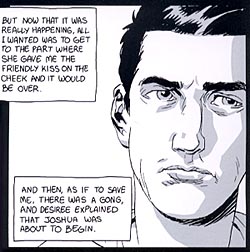 Written by Etgar Keret
Written by Etgar Keret
Art by Asaf Hanuka
104 pages, two-color
Published by Alternative Comics
Some books you read and are glad you took the time to experience, and can’t wait to tell others about. Others you might read and then run out to warn people away from. But then there’s that rare sort of book like Etgar Keret and Asaf Hanuka’s Pizzeria Kamikaze, where you’ll put down the book and appreciate the experience that went through courtesy its creators. But if someone asked you if they should read it? Well, you’re not sure. And that’s ultimately the crux of this book.
 Would people be willing to commit suicide if they knew that in the afterlife, everyone who killed themselves are all together in their own spiritual realm? That’s what Mordy found out the hard way. With everyone looking like they did when they died it’s a slightly strange yet somehow familiar world, even as the mundane drudgery of every day life-after-death continues. Then Mordy finds out that his girlfriend also committed suicide soon after he died, and along with his friend Uzi attempts to find her in a road trip through the routes of purgatory.
Would people be willing to commit suicide if they knew that in the afterlife, everyone who killed themselves are all together in their own spiritual realm? That’s what Mordy found out the hard way. With everyone looking like they did when they died it’s a slightly strange yet somehow familiar world, even as the mundane drudgery of every day life-after-death continues. Then Mordy finds out that his girlfriend also committed suicide soon after he died, and along with his friend Uzi attempts to find her in a road trip through the routes of purgatory.
Keret’s story (adapted from his prose short story “Kneller’s Happy Campers”) is an off-beat, meandering piece. As much time is devoted to the set-up of the world of suicidal afterlife as to the plot itself, if not even more. Maybe it’s because of the imbalance of the two halves, but that’s almost a relief because the plot itself feels like little more than an excuse to have Mordy and Uzi leave the town their in to see the rest of the land and have them do more than hang out at bars and make fun of Kurt Cobain. There are a lot of fragments of world building going on here, from terms invented for those who arrive without any sort of physical trauma due to dying by pills or poison (a “Juliet”), to the discovery that race and religious lines really have vanished in the afterlife. There’s certainly a point that Keret seems to be trying to make as it progresses about miracles and anyone being able to make them happen, but it’s one that’s lost on Pizzeria Kamikaze‘s generally self-absorbed characters. It’s hard to say if it’s hard to warm to Keret’s characters because he’s trying to make a point about people who committed suicide, or if it’s merely a failing in the writing itself instead of authorial intent. (My guess is that it’s the former rather than the latter, but there are arguments for either being the case.) Either way, it’s hard to warm up to these people who stumble through the afterlife still not really caring about others. Mordy at times seems to start breaking free of this mind set, but even it seems hard for him to abandon his old ways. In the end, Mordy’s journey is an interesting one, if in some ways unsatisfying because of the very manner in which it’s taken, with its erratic, aimless, lackadaisical pattern.
 While Keret’s story meanders and feels less focused the further it progresses, Hanuka’s art is the exact opposite as it continues to tighten and refine the more he draws. While the early art of Pizzeria Kamikaze is certainly good in its own right, it’s the later chapters that really show off Hanuka’s skills as an artist. He’s able to draw the “just like the real world” scenes of Pizzeria Kamikaze well, getting all the little moments like Mordy covertly looking into the back seat via the rearview mirror down just right, bringing the intent of Keret’s scenes to life in a just so manner. With each page Hanuka’s lines are sharper and more carefully defined, aided with his use of a second, silver ink for toning and shading to provide additional texture and depth. Even the cover is perfectly framed, with the art shifting from full color into black-and-silver as Mordy’s suicide plunges him backwards into purgatory. It’s a nice trick, both in terms of catching the eye with its split from all colors to just the metallic silver, and by being an actual plot point of the book.
While Keret’s story meanders and feels less focused the further it progresses, Hanuka’s art is the exact opposite as it continues to tighten and refine the more he draws. While the early art of Pizzeria Kamikaze is certainly good in its own right, it’s the later chapters that really show off Hanuka’s skills as an artist. He’s able to draw the “just like the real world” scenes of Pizzeria Kamikaze well, getting all the little moments like Mordy covertly looking into the back seat via the rearview mirror down just right, bringing the intent of Keret’s scenes to life in a just so manner. With each page Hanuka’s lines are sharper and more carefully defined, aided with his use of a second, silver ink for toning and shading to provide additional texture and depth. Even the cover is perfectly framed, with the art shifting from full color into black-and-silver as Mordy’s suicide plunges him backwards into purgatory. It’s a nice trick, both in terms of catching the eye with its split from all colors to just the metallic silver, and by being an actual plot point of the book.
As said before, in the end Pizzeria Kamikaze is a book that one can appreciate the work that went into it, and you’re glad that you read. Is it satisfying enough to recommend to others? That’s a harder question. This is the sort of book for someone who likes the journey as much (if not more so) than the destination. For people who will appreciate Keret’s world-building and Hanuka’s beautiful art, absolutely get this. For those looking for something with perhaps a bit more punch in the plot department, that’s a harder question. Keret’s writing (both here and in other comics) doesn’t offer easy answers, so perhaps it’s apt that even trying to recommend it results in a puzzle with no solution in sight.
Purchase Links:
